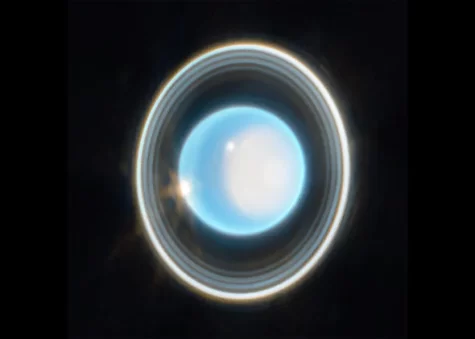Webb #1

Recently, the James Webb Space Telescope captured the best image of Uranus’ rings we have seen. This ethereal photo was taken on February 6th, 2023 with Webb’s Near-Infrared Camera. Showcasing the unique aspects of the planet, the photo has astronomers excited for several reasons. In this article, I’ll walk you through 2 of them.
Uranus’ Rings
This stunning photo showcases 11 of Uranus’ 13 rings. In contrast to Saturn, Uranus’ rings are thin. This, combined with their non-reflective rocky makeup, makes it difficult for telescopes to pick up on their presence. Out of the 13 total rings, 9 are the primary ones. Two others are far fainter and were only discovered during Voyager 2’s mission in 1986. Despite their indistinctness, James Webb was able to capture these two, demonstrating the telescope’s high level of sensitivity. The remaining two rings are even harder to spot. In fact, they weren’t discovered until 2007 by the Hubble Space Telescope. In future studies, however, astronomers believe James Webb will be able to pick up on these rings as well, creating a full picture of Uranus’ beauty.
The Brightening Pole
Uranus is a strange planet, especially with regard to its axis of rotation. Most planets spin around an axis somewhat perpendicular to the plane of their orbit. Uranus’, on the other hand, is tilted 98 degrees from this position. In addition, it takes 84 years for Uranus to complete an orbit. The combination of these two factors makes for long, intense seasons on this icy giant.
During Voyager 2’s mission, Uranus’ north pole was facing out into the darkness of space. However, as of now, the pole has shifted into its summer period, meaning it’s being hit by constant sunlight. This is the region James Webb captured. From the photo, it’s become apparent that on the right side of the planet, the polar cap facing the Sun is brightening. According to NASA, this polar cap is somewhat of a mystery; it seems to appear during the summer and fade away during the fall. Now, with the added news that this region is brightening, Uranus has become an even more intriguing planet to study. Astronomers are hopeful that with James Webb’s powerful imaging technology, data can be uncovered to explain this strange phenomenon.
(he/him/his)
Roshan Mehta is a senior at Shaker High School, and this is his third year participating in the Bison. In the club, he serves as a writer...

